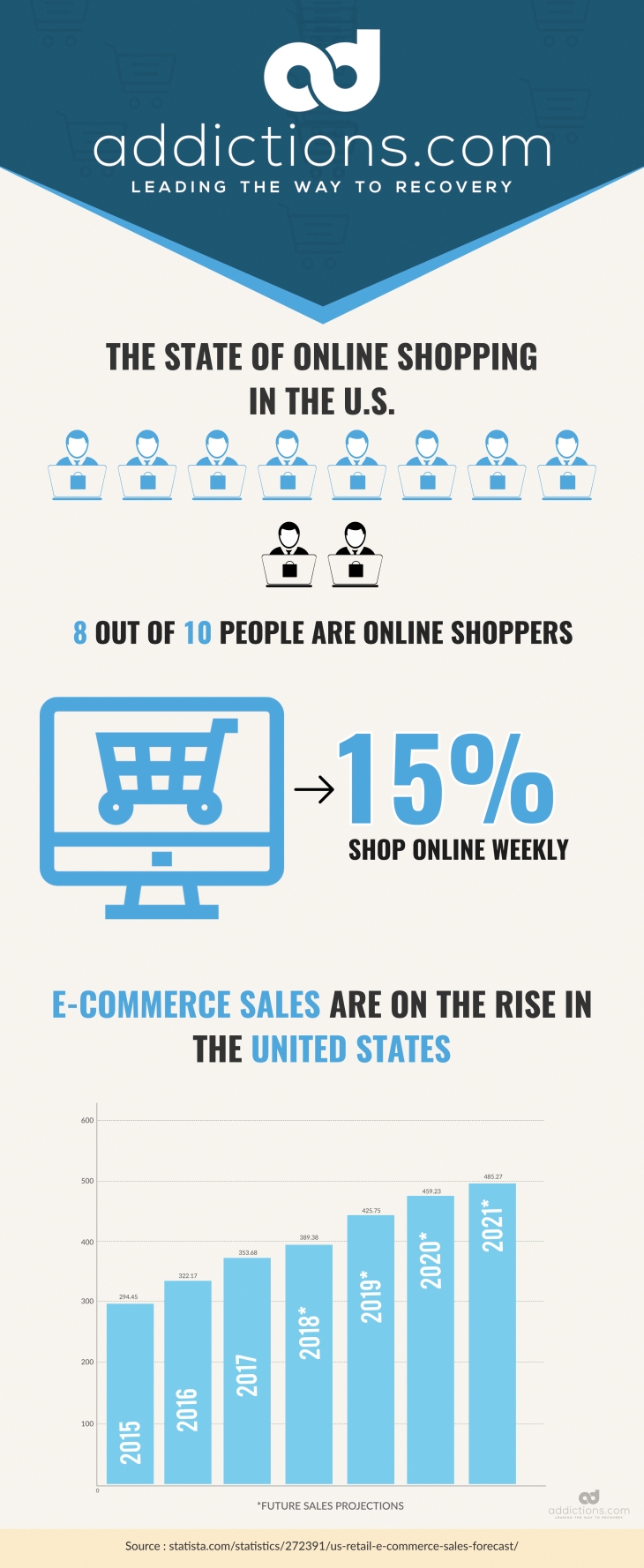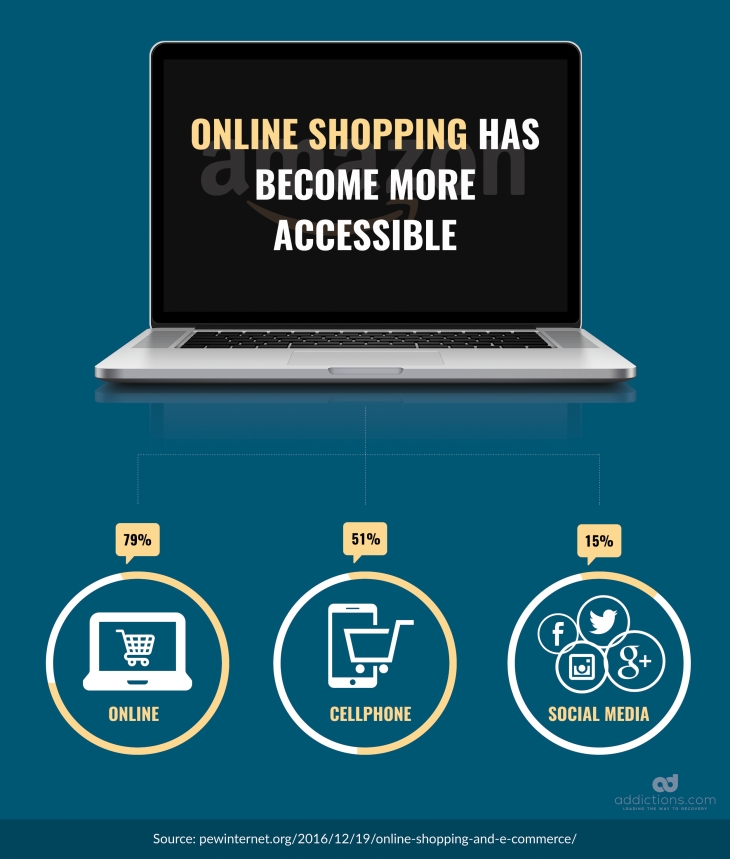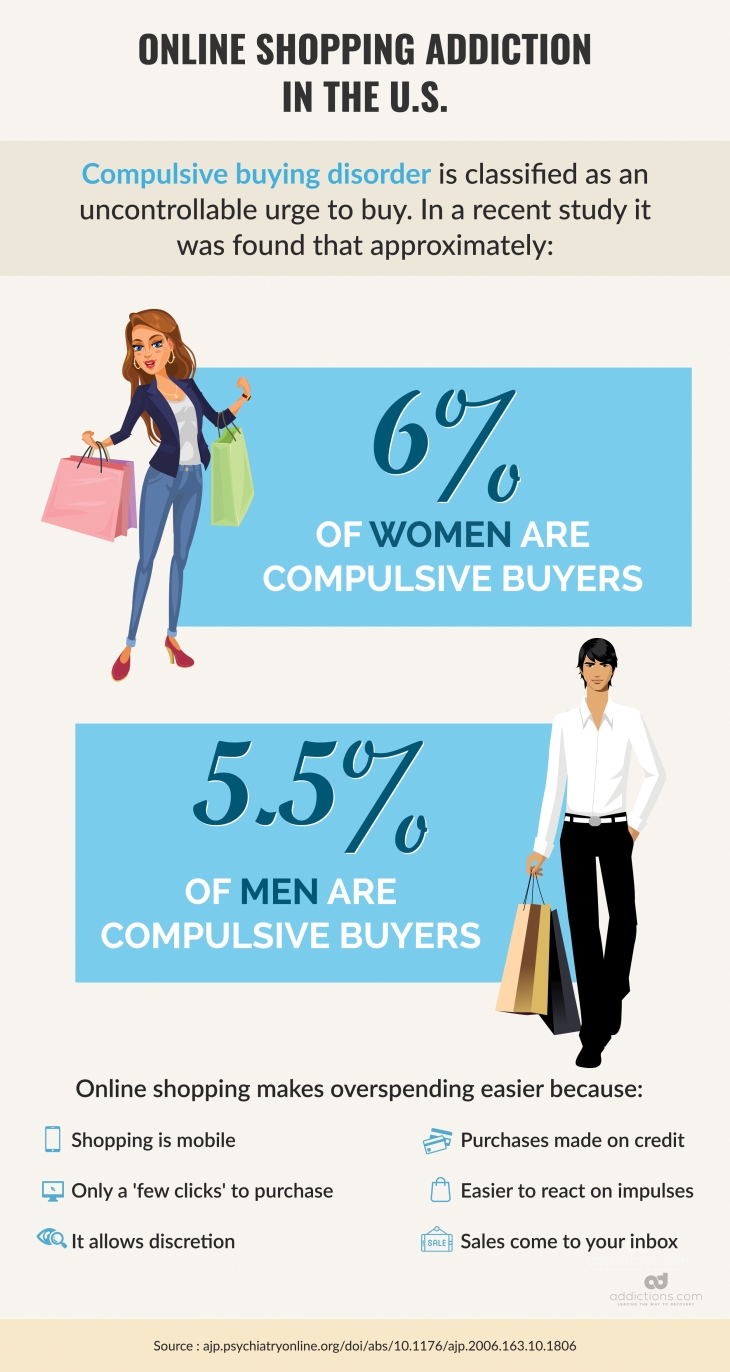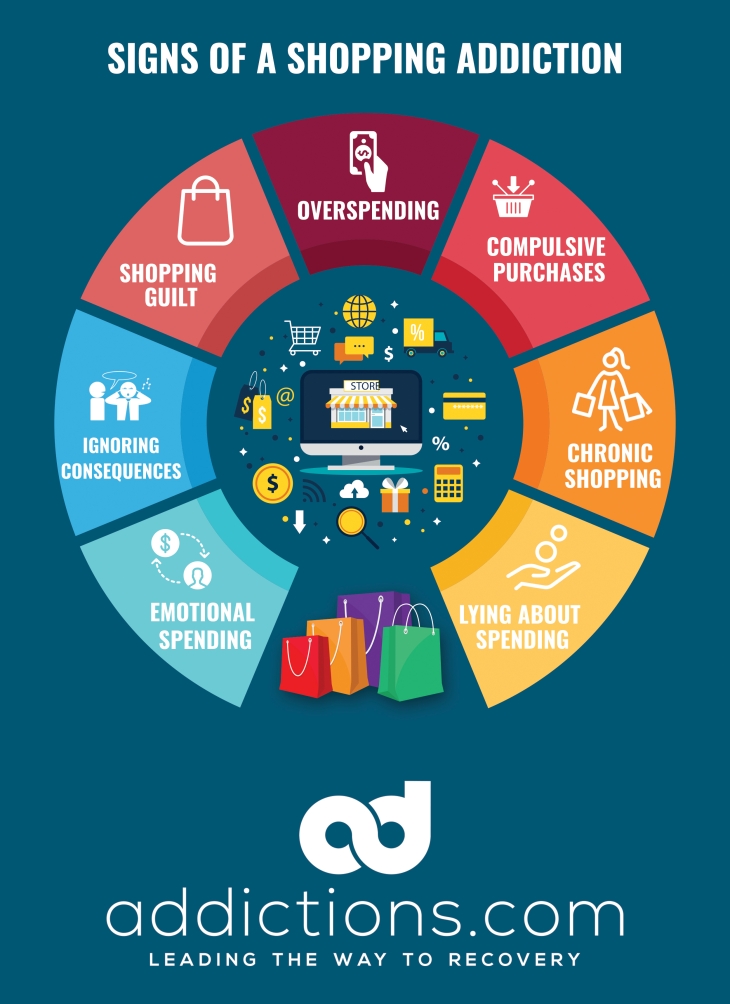Shopping has evolved dramatically within the last 20 years, thanks to the Internet. Online shopping has completely changed the way Americans shop, and can often be more fun, convenient, and less costly than shopping at brick-and-mortar stores. Today, shopping online is as easy as tapping a few screens on your device, and can lead to goods arriving on your doorstep within hours.
Because modern technology has made online shopping easier and more accessible, everyday shoppers are more susceptible to online shopping addiction than ever before. Consumers can simply launch apps like Amazon, eBay, and Etsy directly from their devices no matter where they are and what they’re doing, and have orders placed within minutes. E-commerce retailers even use special marketing tactics on their websites to trick people into buying items they don’t really need.
Online shopping addiction can lead to serious problems with finances, increases the risk for anxiety and depression, and can negatively affect your overall livelihood. Knowing the dangers and signs of online shopping addiction can help you or your loved one identify whether help is needed in the form of treatment. Shopping addiction is commonly treated using interventions like counseling, behavioral therapy, and 12-step support groups.
Here’s a closer look at the connection between the digital age and the prevalence of online shopping addiction.
Online Shopping: A Rising Trend
Online shopping first started gaining momentum in 1995 when Amazon began selling books. Amazon is now the leading e-retailer in the U.S., and generated nearly 136 billion in net sales in 2016. Amazon launched mobile services in 2001, and in 2003, boasted a net profit of over $35 million — a substantial profit considering total U.S. online shopping sales net $50 billion that same year. Amazon remains America’s top online sales giant, as 43 percent of all online retail sales were generated by this company in 2016.
In a survey conducted in 2000 about online shopping, roughly 22 percent of Americans had ever made an online purchase. Today, 51 percent of Americans prefer shopping online, and 96 percent of Americans report having made an online purchase at least once in their life.
In 2015, online shopping sales net over a whopping $294 billion dollars, and is projected to surpass $485 billion by the year 2021. With statistics like these, it’s more important than ever for Americans to become more familiar with the risks and dangers surrounding online shopping addiction.
The Growth of Mobile Shopping in the U.S.
In previous years, one would have to do their online shopping on a laptop or desktop computer. Today, most online retailers have mobile-friendly websites, or dedicated apps that allow you to make purchases with just a few convenient taps. For instance, PayPal, which was founded in 1998, allows people to pay for goods and services in their favorite apps with just one touch, and is integrated across most major websites and platforms. Consumers can now shop for services and goods on their mobile devices any time of day no matter where they are.
Millennials and Gen Xers spend an estimated six hours per week shopping online. Roughly 80 percent of Americans shop online at least once per month, while 30 percent report shopping at least once per week. More interestingly, 43 percent of online shoppers make purchases while in bed, and 20 percent of online shoppers make their purchases while in their cars or using the bathroom.
Mobile shopping is highly convenient, and continues to grow in popularity as a result. Mobile shopping is even commonly performed when drinking alcohol, as one in 10 consumers admit to making online purchases after consuming alcohol. While mobile shopping may be one of America’s favorite unofficial pastimes today, 42 percent of online shoppers admit to having regretted making certain online purchases after placing their orders.
What is Online Shopping Addiction?
Shopping addiction, also known as compulsive shopping or retail therapy, is roughly defined as feeling the desire to go shopping and buy items that are not necessarily needed for the sake of satisfying an urge, or to self-medicate for conditions like depression and anxiety. Those who suffer from shopping addiction are often comically labeled as “shopaholics,” but this addiction type is a serious behavioral condition that can lead to major life problems — including psychological health problems.
Signs of Online Shopping Addiction
Those addicted to shopping will often try hiding their addiction from others. They may pretend to be doing other things on their computers or mobile devices, or shop when nobody else is around.
Here are other common signs and symptoms of online shopping addiction:
- Overspending
- Suffering relationship problems associated with online shopping
- Feeling a rush of pleasure and euphoria when shopping online
- Feeling guilty, angry, sad, or ashamed after shopping online
- Feeling empty or lost when unable to engage in online shopping
- Engaging in online shopping when upset, depressed, or anxious
- Arguing with others about online shopping expenses
- Obsessing over money and online shopping funds
- Buying items you don’t need
- Finding items you forgot about purchasing
- Finding unopened packages from online retailers
- Finding clothing with tags still attached
It’s normal to enjoy a shopping spree every once in awhile, such as on birthdays, or when receiving a new promotion at work. But shopping sprees can become problematic and lead to addiction when shopping becomes excessive, compulsive, and routine, and when one lacks the funds or budget to make purchases.
If you feel as though you may be at risk for suffering online shopping addiction, follow these tips to prevent your shopping and spending habits from turning into a full-blown addiction.
- Distinguish between “wants” and “needs.” Before adding an item to your shopping cart, ask yourself if you need the item, or if you simply want the item. For example, toilet paper is an item you might need, while t-shirts may be items you want, especially if you already own lots of clothing.
- Make a shopping list of things you need, and stick to it. This helps you avoid making impulse buys on items you don’t need.
- Turn off one-click shopping. This can make it more difficult and less convenient for you to shop online. For example, if you have a PayPal account, remove your PayPal information from your favorite sites like Amazon or eBay.
- Find joy in your previous hobbies and interests. Spend less time shopping on the Internet, and devote more time to activities you enjoyed before you started engaging in online shopping. For example, read your favorite books, or head outdoors to play pick-up sporting games with some friends.
- Shop online with a friend or family member. When making online purchases, have your best friend or spouse sit with you as you’re placing the order so they can deter you from making unnecessary purchases.
- Save for later. Many websites allow you to save items to your shopping cart that can be purchased at a later date. Before finalizing your online purchase, save your items for later to give yourself time to determine whether you truly need those items.
What Causes Online Shopping Addiction?
Many who become addicted to online shopping typically suffer one or more psychological conditions, and use shopping as a way to cope with their feelings and emotions. They may feel as though online shopping is the only remedy for stress and depression, or that they must spend money and buy things to remain generally happy.
For many individuals, shopping is associated with a sense of feeling and reward, and triggers a release of dopamine in the brain. Those who engage in online shopping on a routine basis can become tolerant to the increase in dopamine, and shop and spend more frequently to achieve the same feelings of happiness and euphoria. When online shopping spirals out of control, its victims can suffer debt, foreclosure, and other major financial issues.
Online retailers often design their apps and websites in ways that encourage the acts of impulse buying and overspending. Marketers will use certain colors, graphics, and fonts that entice users to click and engage with site content, and rely on analytics to learn more about your personal spending habits. Most major online retailers are linked with PayPal so you can quickly and impulsively make purchases with one click, without having to enter your credit card information every time.
Individuals who suffer from online shopping addiction say they love the feeling of coming home from work, and seeing multiple packages waiting for them outside their doors. Online shopping allows them to shop anytime from the comfort of their own homes, and can make every single day feel like Christmas. However, these same individuals report suffering depression and anxiety when they come home and don’t have packages to open. This is when online shopping has become a serious problem, and when you know it’s time to seek treatment or get help for shopaholics you feel confident can benefit from addiction treatment.
How is Online Shopping Addiction Similar to Other Addictions?
All addiction disorders involve compulsive behavior, and are caused by root psychological reasons. For instance, those who suffer depression may use drugs and alcohol to mask their symptoms, or turn to compulsive behaviors in the form of shopping, playing video games, exercising, or eating. When individuals engage in these activities compulsively to the point it negatively interferes with their overall livelihood, it becomes an addiction.
Just like with any other addiction, online shopping addiction is driven by a spike in a person’s dopamine levels when they engage in the addictive behavior. When a person becomes addicted to shopping or another behavior, their usual favorite hobbies and activities are no longer able to produce the same levels of euphoria. This physiological process is what influences these individuals to compulsively repeat the behavior until they can achieve their desired level of euphoria.
Online shopping addiction can be effectively treated using a number of psychological therapies that address the underlying root causes driving the addiction. Many times, overcoming a behavioral addiction involves learning how to modify negative thoughts and behaviors. Online shopping addiction treatment also teaches patients new, healthy ways to manage and cope with feelings of low self-esteem, low confidence, depression, and other negative emotions.
Treatments for Online Shopping Addiction
Online shopping addiction is commonly treated using support group therapy, behavioral therapy, and cognitive therapy. Support groups like Spenders Anonymous and Debtors Anonymous are often helpful at uniting patients with peers who share similar struggles, and who can share original tips and tricks that can help you stop compulsive shopping. Cognitive-behavioral therapy helps patients identify and overcome negative thoughts and behaviors that may have led to online shopping addiction in the first place.
Those fighting online shopping addiction may also be suffering co-occurring disorders that may be exacerbating their addiction. Co-occurring disorders are mental health disorders like depression, anxiety, and PTSD that coincide with addiction. Most addiction treatment centers will treat patients for co-occurring disorders at the same time, which may involve interventions in the form of prescription medications such as antidepressants, benzodiazepines, and other anti-anxiety medications.
Online shopping can be fun when done in moderation, and can be an effective way to save money and time in place of shopping at local brick-and-mortar stores. But when online shopping takes over your life and interferes with your livelihood, it may be time to get help.




